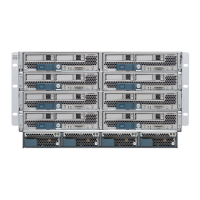5-5
Cisco UCS Invicta Scaling System Administration and Configuration Guide, Version 5.0.1.1a
Chapter 5 Asynchronous Replication
• $ cd ~
• $ chmod 755 .ssh
• $ chmod 600 ~/.ssh/authorized_keys
• (Do a cat authorized_keys and make sure the public key is copied there)
• $ exec /usr/bin/ssh-agent $SHELL
• $ ssh-add
5b. As the Linux root user, type the following command to relabel all the files under the correct
security context for SELinux:
restorecon -Rv /root/.ssh
(These should allow the Cisco array to communicate with the Linux host via password-less ssh)
5c. Get your target LV device ready by using LVM2 tools.
With a multipath setup mapped, the target storage array from the other vendor is mapped as:
/dev/mapper/26439363962386365
5d. Setup the LV using the following commands
• pvcreate /dev/mapper/26439363962386365 vgcreate VG1 /dev/mapper/26439363962386365
• lvcreate -L 90G -n async_lun VG1
• vgchange -a y
• (lvdisplay should now show the LV created as active)
You are now ready to use the LV you created as your Async Target device.
Step 6 Close the session on the remote replication site.
Step 7 Return to the Async Replication window to create a pairing (see Create a Pairing, page 5-7).
Cisco to Linux-RAW
Step 1 Click Public Key to obtain the public key necessary for using password-less ssh access.
The SSH Public Key dialog box appears.
Step 2 Copy the ssh key and click OK.
Step 3 Open a Terminal window and navigate to the /root/.ssh directory.
Step 4 Enter vi authorized_keys.
Step 5 Paste the Cisco Public Key copied in Step 2 into the authorized_keys list and click Enter.
See the following sample
procedure to configure a Linux Host to be used as a Linux ‘Open Target’
partner for Async Replication.
Sample Procedure:

